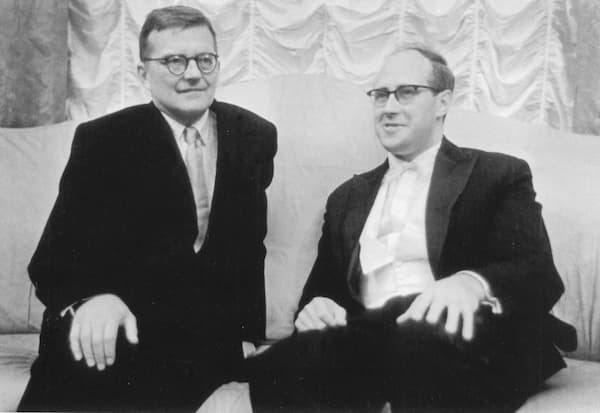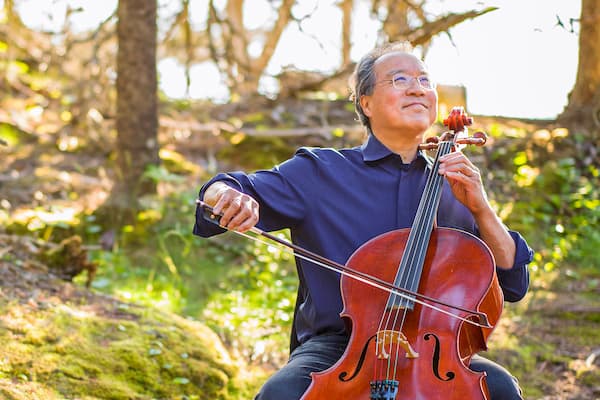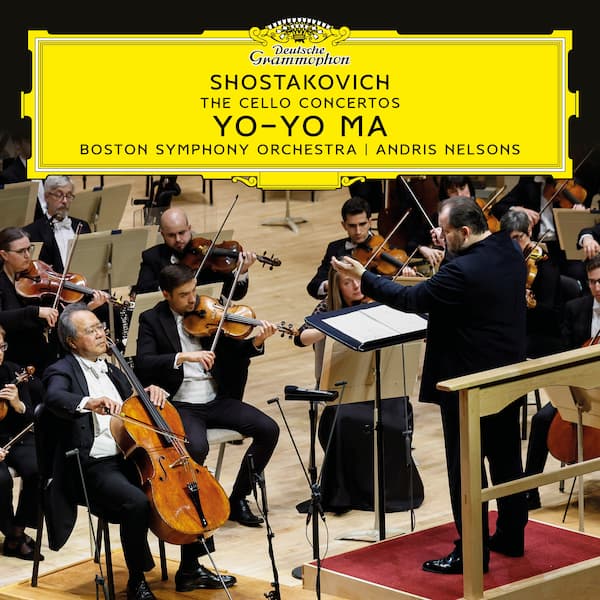The 30-year friendship of Dmitri Shostakovich and cellist Mstislav Rostropovich started in 1943 when Rostropovich was at the Moscow Conservatory. Shostakovich had recently joined the Conservatory, and Rostropovich was part of his orchestration class. The Shostakovich family had left their native Leningrad while it was under siege by the German Army in 1941 and were evacuated to Kuybyshev (now Samara), which was to be the alternative capital should Moscow fall to the Germans.
In 1954, at the Moscow Conservatory, Rostropovich performed Shostakovich’s Cello Sonata, Op. 40, with the composer at the piano. Next came the Cello Concerto.
The Cello Concerto was announced in Soviet Culture in June 1959. In July, Rostropovich and his pianist, Alexander Dedyukhn, went to Leningrad to discuss the concerto in detail. Shostakovich played it through on piano, and it brought Rostropovich to tears, ‘shaken to the core’. The concerto was dedicated to the cellist, and when given the score, he learned it by heart in 3 days. Rostropovich and Dedyukhn then played it for Shostakovich, who was delighted.
The premiere was held at the Leningrad Conservatory with Leningrad Philharmonic Orchestra conducted by Yevgeny Mravinsky. The orchestra is small: 2 flutes, 2 oboes, 2 clarinets, 2 bassoons, 1 horn, timpani, celesta, and strings. No trumpets, no trombones, and no tuba. Movements 2 through 4 are played without pause (attacca); movement 3 is marked Cadenza.

Shostakovich and Mstislav Rostropovich in the Blue room of the Great Hall of the Leningrad Philharmonic after the premiere of the First Cello Concerto. 4 October 1959. © Dmitri Shostakovich: Pages of His Life in Photographs
This concerto has 4 movements and opens with a 4-note motif (G, F-flat, C-flat, B-flat) that seems to be an inversion of Shostakovich’s own 4-note name motif (D, E-flat, C, B), D-S-C-H, that he used extensively at this time. The 4-note motif, with its pairs of half steps, drives the rest of the work.
Dmitri Shostakovich: Cello Concerto No. 1 in E flat Major, Op. 107 – I. Allegretto
In 1966, Shostakovich completed his second Cello Concerto, also intended for Rostropovich. Rostropovich gave the premiere in Moscow, with Yevgeny Svetlanov and the USSR State Orchestra. This concerto looks to the dark side and carries a feeling of introspection. Melancholy themes abound and some elements of playful darkness seem more like a danse macabre in the first movement. Shostakovich relies on the feeling of irony in his juxtaposition of serious cello music with light and dancing melodies for the xylophone, harp, and woodwinds.
The 2nd concerto is considered one of the hallmarks of Shostakovich’s late style. Like the first concerto the brass section is confined only to horns, but a contrabassoon is added to the wind section. The percussion section, however, is greatly expanded, and two harps are added to the orchestra.
The first movement Largo begins with solo cello before it’s joined by cello and basses in octaves. The second movement uses a street song from Odessa, Bubliki, kupitye, bubliki (Buy My Bagels). The lyrics use the subject of a bread-seller, but about the desperate conditions under the New Economic Policy era (1921–1928) describing an unwashed street seller, clad only in rags, selling bagels and lamented about the poor state of her family. The lyrics, by Yakov Yadov, were written to a violin melody that was used by the street sellers of bagels and was banned until 1980 because of its subversive themes.
The horns come to the fore at the beginning of the last movement with fanfares before the cello enters with a cadenza. The cello, accompanied only by a tambourine, makes a virtuosic statement. The rest of the movement are lyrical, then march-like, before ending in a dance. Percussion has a much larger role in this concerto than they did in the first concerto.

Yo-Yo Ma © Mann

Andris Nelsons © Marco Borggreve
Yo-Yo Ma’s new recording of the two concertos with the Boston Symphony orchestra led by Andris Nelsons brings us both concertos in their finest form. The legacy of Rostropovich the virtuoso matched with the creativity of Shostakovich comes through in Ma’s performance. Special sections, such as the end of the first concerto’s slow movement, which ends in a duet between the cello, playing harmonics, and the celesta whispers secrets of mysterious nature. The first concerto is considered one of the most difficult for cello and comes off beautifully.

Shostakovich: The Cello Concertos
Yo-Yo Ma, Boston Symphony Orchestra, Andris Nelsons, cond.
Deutsche Grammophon 00028948669493
Release Date: 25 April 2025
For more of the best in classical music, sign up for our E-Newsletter
